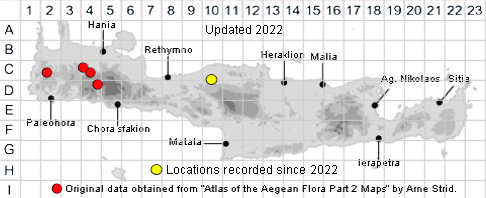
SPECIES DESCRIPTION
SCILLA CYDONIA
Family and Genus:- See- HYACINTHACEAE
Common Names:- None
Homotypic Synonyms:- Scilla nivalis
Meaning:- Scilla (Gr) Ancient name for squill.
Cydonia (L) The Latin name for an "apple" tree from Cydon (Hania).
General description:- Glabrous perennial.
Bulb:-
1) 15-20 x 10-14 mm, ovoid; external tunics brown, internal tunics white.
Scape:-
1) Solitary, 4-15 cm, terete, slender.
Leaves:-
1) 2-4, synanthous, 8-10 cm x 2-7 mm, canaliculate, cucullate.
Flowers:-
1) Raceme, 1-4-flowered, pedicels erect, 4-15 mm.
2) Bracts, minute or absent.
3) Perianth, stellate, segments free, persistent, 5-8 x 1.5-2.6 mm, greyish blue to
wine-reddish above, with greenish midvein beneath.
4) Filaments, filiform. 5 x 0.7 mm, greyish blue to wine-reddish.
5) Ovary, globose, mauve with yellowish nerves. Ovules, subglobose, c. 4 per
loculus.
6) Style, 2 mm.
Fruit:-
1) Capsule, irregularly globose.
2) Seeds, 2 mm, with a white elaiosome, testa black when dry, shiny.
Key features:-
1) A slender Scilla distinguished by its green buds and its pale ovary.
Habitat:- Castanea groves, Quercus ilex woodland, maquis, on stony soil with a ±
shallow humus layer over phyllitic schist, (100-)400-1900 m.
Distribution:- Endemic W. Crete & Karpathos. So far on Crete known from three
wet, non-calcareous valleys north-west of the Lefka Ori. Possibly underrecorded
due to its early flowering time and to be looked for in other maquis regions of Crete.
Flowering time:- Feb to early July, depending on altitude.
Photos by:- Fotis Samaritakis
Descriptive text:- By kind permission of Ralf Jahn.
Comment:- Extract from "Flowers of Crete" by Nicholas Turland et al.
"Scilla Cydonia was described in 1998 for the Cretan area representatives of the
widespread S. bifolia complex. This is a ‘true’ Scilla, with free tepals, and not a
former Chionodoxa."
